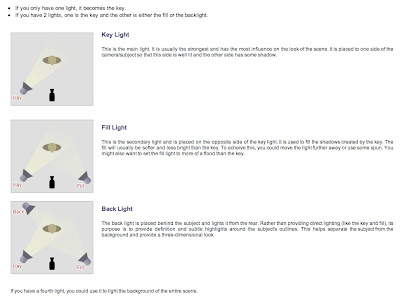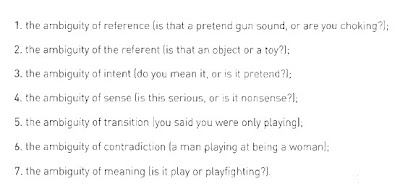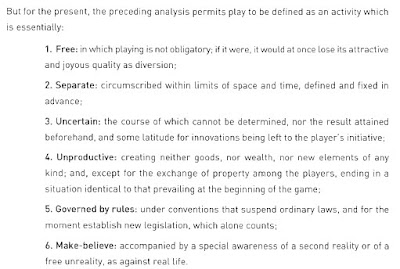MISE-EN-SCENE: What's in the shot
Setting
Costume
Lighting
Figure Expression and Movement
LIGHTING: 3 POINT LIGHTING: key, fill, back

MACHINIMA: Environment lighting, and also lighting kits, or lights you make
PHOTOGRAPHIC QUALITIES OF THE SHOT
Look of an image
balance of dark and light
depth of space in focus
relation of background and foreground
use of color, saturation, tone
focus
lenses to change depth in a shot (either fixed with a telephoto or fish eye, or rack or zoom shots)
FRAMING
Angle
Height of the camera
Canted angles
Following shot (moving camera):PANNING, TRACKING, TILTING, CRANING
Point of view shot
SCALE/PROXIMITY
ELS: landscape, crowd, building--establishing shot
LS: Standing human figure is height of screen (roughly)--character and surroundings
MLS: knees/mid-thigh up (shot Americain bc of its use in cowboy pictures)
MCU: chest up--get to see the face, gestures
CU: head
ECU: small object, part of the body
CAMERA MOVEMENT
crane
handheld, steadycam
pan
tilt
tracking shot
whip pan
For Machinima: Space Navigator 3-d mouse
What to do with those shots!
EDITING AND MONTAGE
Editing can be based on rhythm, time, space, tone, theme
"The Kuleshov Effect" With his experiment, Kuleshov learned 3 things:
1) a cut could serve a narrative function (eyeline match, flashback, what a character is thinking)
2) also it could generate an intellectual response—(metaphor, contrast, parallel)
3) emotional cut: rhythmic, tonal (increasingly dark or light0, form cut (match cut), directional cut
a single cut can function on all three levels: narrative, intellectual, emotional
Straight cut
Jump cut
Cross cut (or parallel cut)
Contrast cut
Form cut (match cut)
TRANSITIONS:
Fade-out
Fade-in
Dissolve
Synecdoche (part for a whole)
Form dissolve
Wipe
Iris




